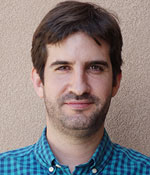News from the Chair
Prof. Manjavacas Receives Prestigious NSF CAREER Award

Artistic view of the angular momentum transfer along a chain of rotating nanoparticles mediated by the fluctuations of the electromagnetic field.
Credit: Manjavacas Lab 2020
Professor Alejandro Manjavacas has been awarded a five-year NSF CAREER award for a project entitled Transfer of Momentum and Energy in the Nanoscale Using Quantum and Thermal Fluctuations. This unique project takes advantage of the quantum nature of the interaction of light and matter to develop possible new applications in nanotechnology. The work should point toward new ways of manipulating objects on the nanoscale, including in biological settings, as well as improvements in design of thermophotovoltaic devices and heat management in nanoelectronics.
Here is a detailed description of the proposal:
The interaction between light and matter in the nanoscale can be very different from our daily macroscopic experience. When the dimensions of material structures, or the space separating them, reach the range of nanometers, the quantum nature of light and matter emerges, giving rise to new phenomena. In that limit, Casimir interactions, which arise from quantum and thermal fluctuations of the electromagnetic field, play a dominant role and can overcome other interactions, such as gravitational forces, thus conditioning the dynamics of nanoscale objects. The fluctuations of the electromagnetic field are also at the origin of the radiative transfer of energy between bodies at different temperatures. In this context, and thanks to the enormous advances in nanofabrication technologies, we have reached the limit in which the effects caused by the quantum and thermal fluctuations of the electromagnetic field have important consequences for the mechanical and thermal dynamics of nanostructures. This has posed new challenges for the development of applications in nanotechnology. However, it also constitutes a unique opportunity to develop new approaches to manipulate the mechanical and thermal dynamics of nanostructures.
In this project, we will tackle this research challenge by investigating the transfer of momentum and energy between nanoscale objects within the context of two novel concepts that have recently emerged in nanophotonics: structures with atomic thickness and spin-orbit interactions of light. The investigation of these phenomena within a common theoretical framework will allow us to establish the foundations for new paradigms enabling noncontact transfer of momentum and energy in the nanoscale, which can help to develop novel approaches to manipulate nanoscale objects, including biologically relevant structures. Furthermore, the results on the energy transfer will have an impact on the improvement of thermophotovoltaic devices and heat management strategies in nanoelectronics. At the same time, this project will be an opportunity to improve the recruitment and retention of STEM students, which is one of the most important structural problems that education in New Mexico currently faces, with a special emphasis on targeting first-generation and low-income students from underrepresented minorities. To that end, we will implement a range of activities targeting students from middle school to the graduate level, which aim to build interest in STEM disciplines, preserve that interest, and mold it into essential skills and experience.
See the NSF Award Abstract
Department of Physics and Astronomy
The University of New Mexico
Physics, Astronomy, and Interdisciplinary Sciences building (PAÍS)
210 Yale NE
Albuquerque, NM 87106
505-277-2616
505-277-1520 fax

